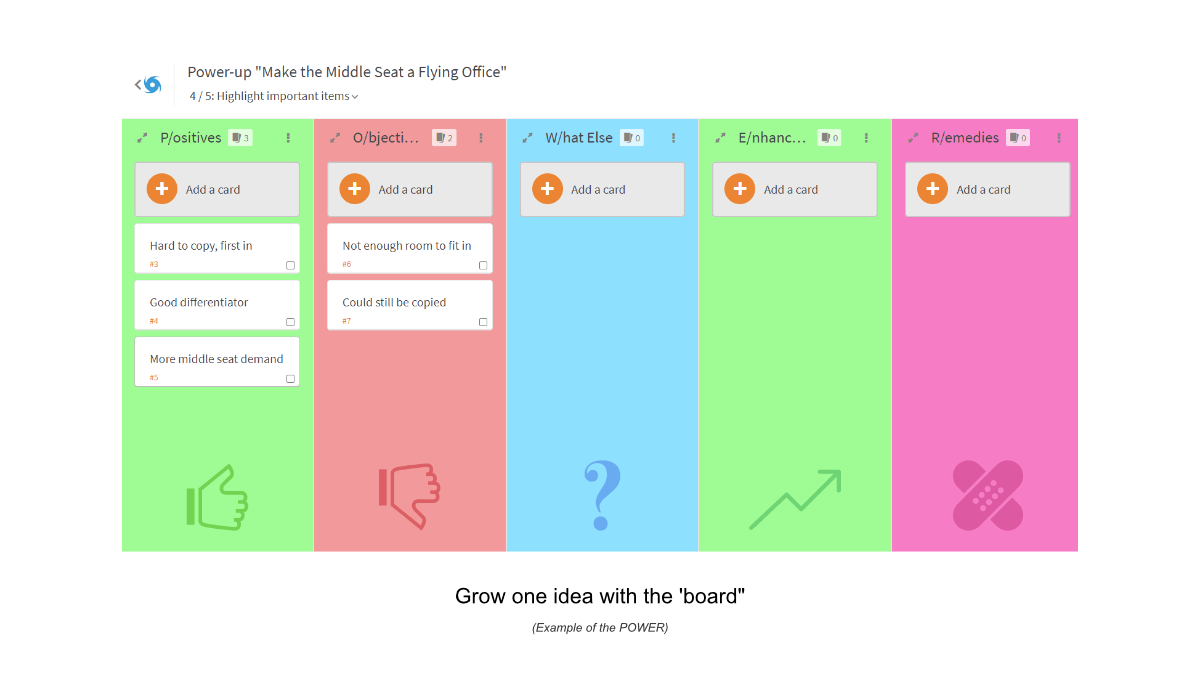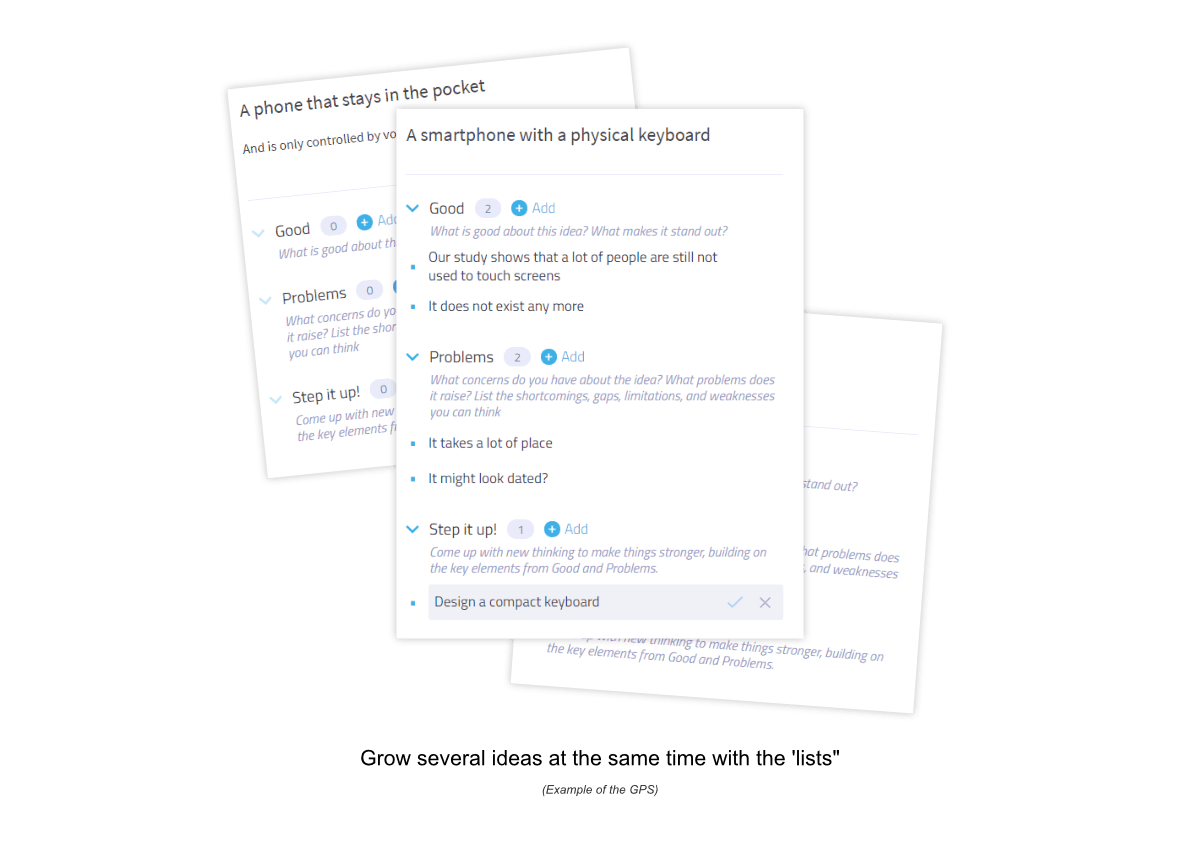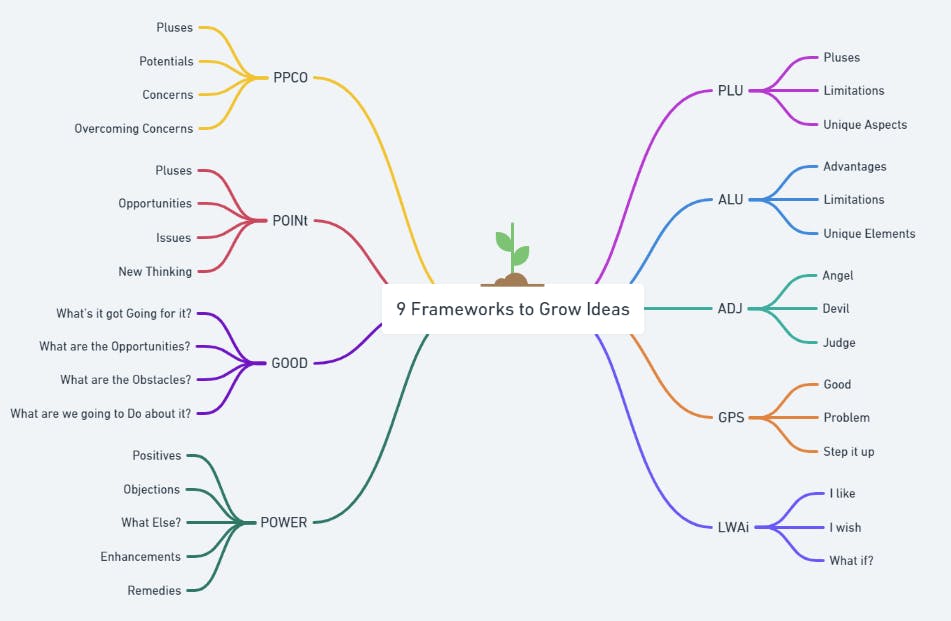Collaboration and creativity are not only about generating as many new ideas as possible. That’s only the first step in the creative process but sadly, most people think their work is done at that point. They’re forgetting the most important part: turning the seeds of the most promising ideas into robust concepts, nurturing and growing them to unleash their full potential.
The good, the bad, and the unique
There are plenty of creative frameworks and processes out there designed for that very same purpose: co-developing and enriching, collectively, ideas after an ideation stage.
This article will look at the most efficient and popular ones, based on our own experience and on the feedback of our community of facilitators, who kindly contributed with their ideas.
The 10 framework to develop your ideas
- PLU: Pluses, Limitations, Unique Aspects
- ALU: Advantages, Limitations, Unique Elements
- Angel Advocate: Angel, Devil, Judge
- GPS: Good, Problems, Step It Up
- PPCO: Pluses, Potentials, Concerns, Overcoming Concerns
- POINt: Pluses, Opportunities, Issues, New Thinking
- GOOD: What’s it got Going for it?, What are the Opportunities?, What are the Obstacles?, What are we going to Do about it?
- “I like… I wish… What if…?”
- POWER: Positives, Objections, What Else?, Enhancements, Remedies
- SCAMPER: Substitute, Combine, Adapt, Modify, Put to another use, Eliminate, and Reverse
As you’ll notice, most of them more or less follow the same 3-step structure to analyse, evaluate and grow your ideas. It can be summarized with the most basic of all frameworks: Pros / Cons / Improvement: first you identify what’s good, promising or unique about an idea; then, you look at the problems, uncertainties or obstacles that might get in the way; and finally, taking into account the results of these first two steps, you brainstorm and co-develop solutions to bring your ideas to the next level. Pretty simple, no?
On the other hand, they all have their own subtle differences and inconspicuous details that makes each and every one of them unique. Practice and experience will help you understand the tiny little tweaks - often linked to how the different steps are called - differentiating them from one another, and allow you to choose the appropriate frameworks according to your goals and your audience.
The 9 most powerful frameworks to co-develop your ideas
Here’s a quick and non-exhaustive breakdown of the best creative frameworks to grow your ideas with your teams and collaborators :
PLU (Pluses / Limitations / Unique Aspects)
PLU ranks among the most basic creative frameworks, which can also make it one of the most efficient ones if well implemented and facilitated. Its originality lies in the third step: “Unique Aspects” truly encourages your participants to look at the “idea within the idea”, the little gem that could be hiding in a thought that might at first seem pretty common.
ALU (Advantages / Limitations / Unique Elements)
Used by the International Center for Studies in Creativity in the 1990s, the is pretty similar to the previous one and also a useful tool to have at your disposal.
Angel / Devil / Judge
Another popular variant is more imaginative in its wording: Angel / Devil / Judge, which can be useful to make your participants take on different roles throughout the co-development phase and truly look at the idea from three distinct angles.
GPS (Good / Problems / Step It Up)
Masterfully coined by Tim Hurson, the well-known GPS follows the 3-stage process mentioned earlier, with a more memorable acronym. Due to the wording of its third step, GPS is much more action-oriented than other similar frameworks and really helps you go beyond the challenges to find actionable solutions to implement. Another plus side of GPS is that it’s incredibly simple to explain compared to other frameworks.
PPCO (Pluses / Potentials / Concerns / Overcoming Concerns)
Developed by Diane Foucar-Szocki, Bill Shepard and Roger Firestein and CEF’s reference framework, PPCO is a highly powerful CPS process in… four sections: Pluses / Potentials / Concerns / Overcoming Concerns. More detailed than the previous ones, the PPCO framework divides the first stage into two different steps to look, not only at the obvious strengths of an idea but also investigate its hidden strong points and potential. “Concerns” is also a more constructive way to frame the discussion, rather than looking at the “problems” of an idea. Also, do not forget to formulate concerns as "How Might We" questions!
POINt (Pluses / Opportunities / Issues / New Thinking)
Created by Miller, Vehar and Firestien in the early 2000s, the POINt is a variant of PPCO, its main difference lies in the “New Thinking” label, which can prove very powerful to choose the most important issues and concerns about an idea and brainstorm about different ways to overcome them in an entirely new mindset.
GOOD (What’s it got Going for it? / What are the Opportunities? / What are the Obstacles? / What are we going to Do about it?)
The GOOD framework follow pretty much the same pattern, although in an interrogative form - which could be useful to open up the debate and discussion.
“I like… I wish… What if…?”
Developed by IDEO, “I like… I wish… What if…?” is somewhat similar to the POINt in its ability to open up the debate and new possibilities, and a highly efficient tool to frame the feedback of your participants in a constructive way to move forward.
POWER (Positives / Objections / What Else ? / Enhancements / Remedies)
Last but not least: also developed by Tim Hurson, the five-step POWER framework is an absolute gem to dig deeper into both the potential and possible pitfalls of any idea. Its originality lies in the third step, designed to create associations with other ideas and concepts, and in its ability to distinguish two types of improvements: improving what’s good about an idea (“Enhancements”) and fixing what’s wrong about it (“Remedies”).
SCAMPER
A different kind of beast, with SCAMPER, you are going to identify the different building blocks of your idea and then go through a series of questions that will help you transform your idea into a more robust concept.
If you are interested, I have created a full guide on how to facilitate a SCAMPER workshop.
How to grow your ideas with Stormz?
With the Stormz application, there are two principal alternatives at your disposal:
One idea at a time with the "Board"
If you would rather develop one idea at a time, create one cluster per element of the framework (like with our POWER template).

Several ideas at the same time with the "Lists"
If you need to develop several ideas at once, create one "list" per element of the framework (like with our GPS Brainstorming template).
By the way, good news, we have just released a series of upgrades to the "lists".
 Other than embracing the “greenhousing mindset”, which stands at the core of the ability to grow ideas, we can only encourage you to test these different frameworks in a workshop, as often as possible until you unravel and master all their creative secrets.
Other than embracing the “greenhousing mindset”, which stands at the core of the ability to grow ideas, we can only encourage you to test these different frameworks in a workshop, as often as possible until you unravel and master all their creative secrets.
Note from our founder: Special thanks to the facilitators who contributed to the discussion about these frameworks on our Facebook group: Dorte, Sunil, Sylvain, Jonathan, Lina, Brian, Mimi, Hector, Asmâa, Susan, Katie, Russ, Lindsay, Ginny, Sharon and Harry!
